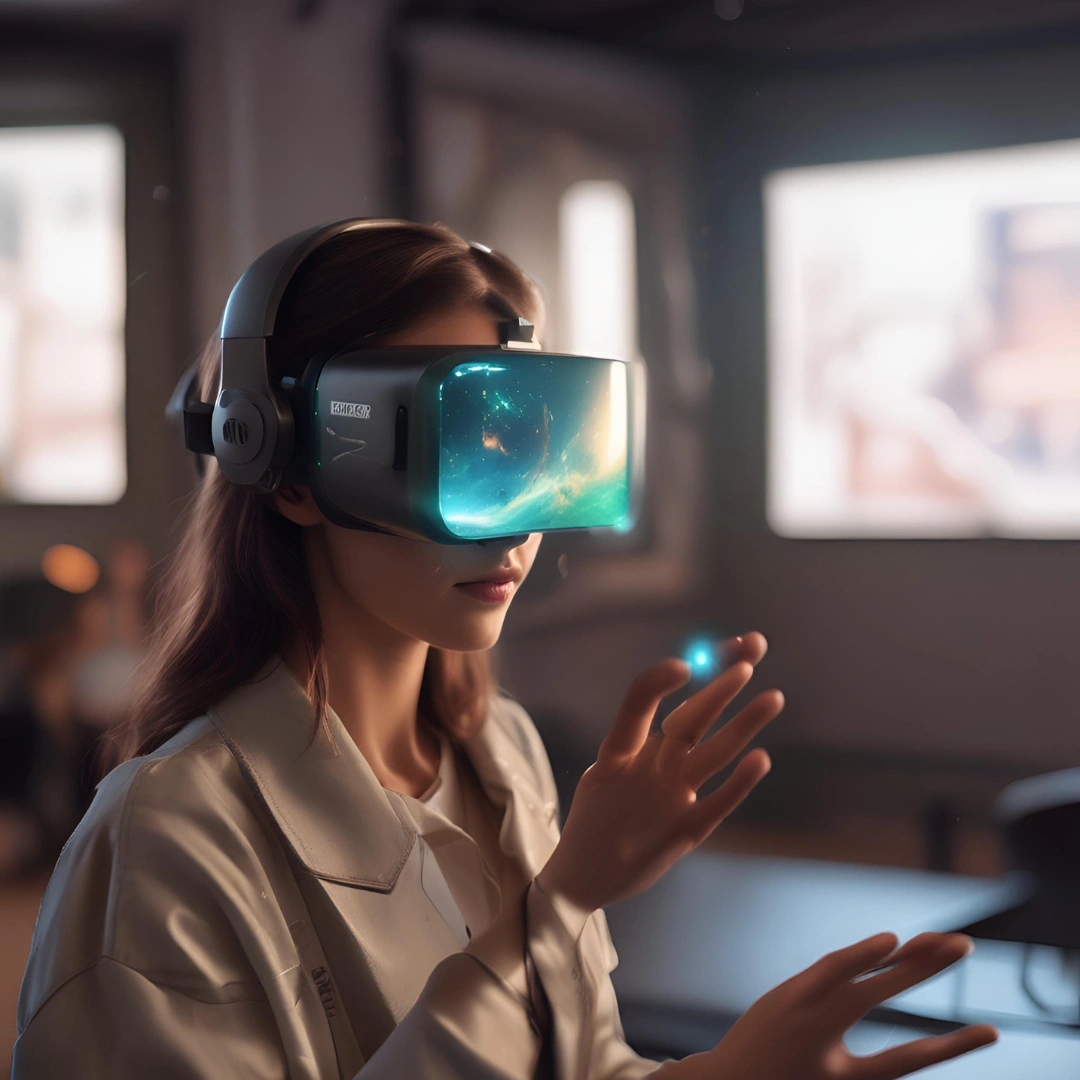The realm of digital innovation is rapidly shifting, and Extended Reality (XR) emerges as a groundbreaking innovation that will redefine how we engage with our surroundings. XR seamlessly blends Virtual Reality (VR), Augmented Reality (AR), and Mixed Reality (MR), blurring the boundaries between the physical and digital domains, and crafting captivating experiences that enrich our everyday lives, work, and leisure. This comprehensive guide explores the complexities of Extended Reality, its diverse applications, advantages, obstacles, and the promising horizon that lies ahead.
Understanding Extended Reality (XR)
Extended Reality (XR) is an umbrella term that encompasses all immersive technologies. It includes Virtual Reality (VR), which creates fully immersive digital environments; Augmented Reality (AR), which overlays digital information onto the physical world; and Mixed Reality (MR), which seamlessly blends the real and virtual worlds, allowing for interaction with digital objects as if they were part of the physical environment.
Key Components of XR:
-
Virtual Reality (VR):
-
Headsets: Cutting-edge virtual reality devices, such as Oculus Rift, HTC Vive, and PlayStation VR, offer users a fully captivating and deeply engaging experience, transporting them to entirely new digital worlds.
-
Applications: VR technology finds extensive application in diverse domains, including interactive gaming experiences, immersive training environments, virtual exploration of spaces, and therapeutic interventions.
-
-
Augmented Reality (AR):
-
Devices: Handheld devices, touchscreen tablets, and augmented reality headsets such as Microsoft's HoloLens and Google's Glass offer users a diverse array of digital capabilities.
-
Applications: Augmented reality, or AR, has found diverse applications across various sectors. It guides people through unfamiliar environments, allows shoppers to virtually test products, enhances learning experiences, and assists in maintaining industrial equipment. From navigating new locations to enhancing retail and educational interactions, AR has become a versatile tool that seamlessly integrates digital information with the physical world.
-
-
Mixed Reality (MR):
-
Devices: Cutting-edge wearable devices, such as the Microsoft HoloLens 2 and Magic Leap, offer remarkable capabilities that push the boundaries of immersive technology. These state-of-the-art headsets seamlessly blend physical and digital realms, empowering users to experience augmented reality in unprecedented ways.
-
Applications: Virtual reality offers immersive solutions for teamwork, product development, and hands-on learning. Its interactive nature enables seamless collaboration, iterative design, and engaging instruction across diverse applications.
-
Applications of Extended Reality
Extended Reality is revolutionizing various industries by providing new ways to interact with digital and physical environments:
-
Gaming and Entertainment:
-
Immersive Gaming: XR technology enables captivating gaming worlds where people can fully engage with virtual elements and surroundings, making the experience feel genuinely life-like.
-
Virtual Concerts and Events: Virtual worlds like VRChat and AltspaceVR offer a place for people from all corners of the globe to come together and take part in shared experiences, such as virtual events, live music performances, and social activities.
-
-
Education and Training:
-
Interactive Learning: XR tools elevate the way we learn by offering engaging and realistic educational material that fully immerses students in the subject matter.
-
Professional Training: Virtual reality (VR) and mixed reality (MR) have become invaluable tools for training in various industries, including medicine, aviation, and manufacturing. These technologies enable professionals to engage in realistic, hands-on practice without the dangers inherent in real-world training. This allows them to develop their skills and knowledge in a safe, controlled environment, ultimately enhancing their performance and preparedness for real-world scenarios.
-
-
Healthcare:
-
Surgical Simulations: VR offers a safe and controlled space for surgeons to hone their skills, enabling them to rehearse medical procedures without putting patients at risk.
-
Therapy and Rehabilitation: XR (extended reality) technology has become an invaluable tool in the field of healthcare, particularly in physical therapy and mental health treatments. By immersing patients in captivating and interactive experiences, XR enables more engaging and impactful therapeutic sessions, leading to better outcomes for those receiving care.
-
-
Retail and E-commerce:
-
Virtual Try-Ons: AR technology allows people to see how different products would look on them without actually wearing or using them. This digital feature gives customers the chance to experiment with various items, such as clothing, jewelry, and cosmetics, before deciding to buy them. By utilizing augmented reality, individuals can get a realistic preview of how these products might appear and fit, helping them make more informed purchasing decisions.
-
Enhanced Shopping Experiences: Augmented and virtual reality applications unlock captivating and engaging shopping journeys, whether you're browsing from home or exploring physical retail spaces.
-
-
Architecture and Real Estate:
-
Virtual Tours: Virtual reality (VR) technology enables prospective homebuyers and tenants to explore properties remotely, elevating the real estate search process. Potential customers can now immerse themselves in a digital walkthrough, gaining a more comprehensive understanding of a property before visiting in person.
-
Design and Visualization: Architects and designers leverage Mixed Reality technology to envision and engage with their creations in the moment, empowering them to swiftly make refinements and enhancements.
-
-
Industrial and Manufacturing:
-
Maintenance and Repair: Augmented Reality (AR) empowers technicians by delivering timely data and step-by-step instructions, resulting in more efficient and precise maintenance and repair procedures.
-
Training and Simulation: XR technologies offer a safe and controlled space for industrial workers to rehearse and hone their skills through virtual simulations. This immersive training approach empowers workers to practice job-related tasks without the risks associated with hands-on experience in the physical workplace.
-
Benefits of Extended Reality
The adoption of XR technologies offers numerous benefits across various sectors:
-
Enhanced Learning and Training:
-
Interactive Experiences: Immersive XR experiences elevate learning, allowing for better comprehension and the development of practical abilities. These innovative technologies enhance the way people acquire and retain new knowledge and skills.
-
Safe Training Environments: By enabling risk-free training in challenging or complicated circumstances, XR lowers the possibility of errors and accidents.
-
-
Improved Accessibility and Convenience:
-
Remote Access: XR makes it possible to receive training, education, and cooperation remotely, which eliminates the requirement for travel and in-person attendance.
-
Personalized Experiences: By adapting to specific requirements and preferences, XR technologies improve user experiences.
-
-
Increased Productivity and Efficiency:
-
Real-Time Information: Task accuracy and efficiency are increased by the real-time information and direction that AR and MR deliver.
-
Collaboration: By enabling teams to engage with digital content and one another in immersive settings, XR improves teamwork.
-
-
Cost Savings:
-
Reduced Training Costs: Training expenses are decreased since XR eliminates the requirement for real training locations and resources.
-
Improved Design Processes: Early identification and repair of design problems is made possible by XR, which lowers the price of rework and revisions.
-
Conclusion
Extended Reality (XR) is revolutionizing how we engage with the digital and real worlds by providing immersive experiences that improve daily living, work, education, and entertainment. The potential for XR to transform a number of industries is growing as technology advances, opening up new avenues for engagement, efficiency, and innovation. Even though there are still obstacles to overcome, XR has a bright future ahead of it because to continuous improvements and growing usage, which will create a world that is more immersive, interactive, and linked. Accepting XR will change how we view and engage with reality itself in addition to our digital experiences.





Leave a Reply